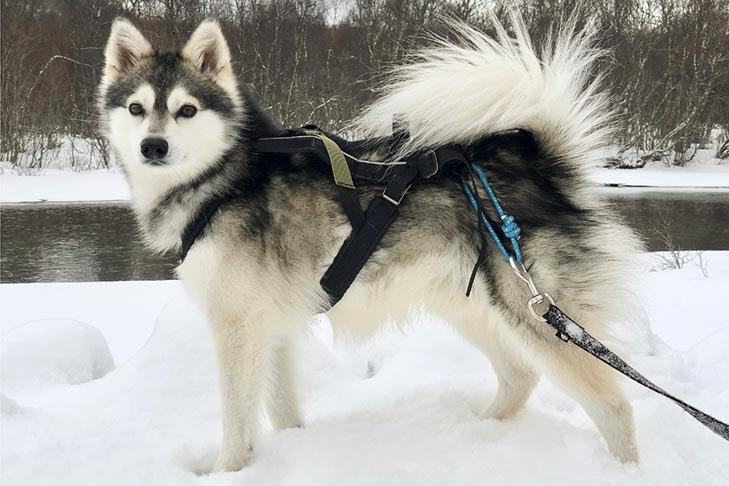The Challenges With Owning An Alaskan Klee Kai
The Alaskan Klee Kai is a fairly new breed, and it’s been created to be a companion dog. They’re devoted to their family and can make their wishes known through vocalization. They’re skittish around strangers and require early socialization training.
These dogs are intelligent, but they can also be stubborn. This can make training difficult for the inexperienced pet owner.
1. Training
Alaskan Klee Kai are intelligent dogs that enjoy learning and a challenge, but they can be independent and stubborn. They can be easily trained with positive reinforcement, but they need consistency in order to thrive. Keeping training sessions short and fun for them can help ensure they are engaged and focused. They also tend to do better with more positive experiences around people and new situations, which can help prevent anxiety and territorial behavior.
Because they have a high IQ and are eager to please, these dogs learn very quickly. However, if they are not trained early on, they may develop bad habits that become harder to break later on. This is why it’s important to take them to obedience classes and begin socialization as soon as possible, so they get used to different people and environments before they are adults.
Since they have a tendency to seek out attention, it can be easy for them to act up in an attempt to get it. This can include leaping up on people or whining when they want to be petted, but it can also involve escaping, such as digging under or over fences. This can be dangerous for them, so it’s important that they are walked on leashes or in fenced-in areas at all times.
Exercise is another important consideration. These dogs need moderate to high levels of activity each day to keep them happy and healthy. They can become destructive when they are bored or anxious, so they need plenty of time to play and exercise. They enjoy long walks and hikes, playing fetch, and other dog sports like agility, rally, and nose work.
Because they have such a deep desire to please, these dogs can do very well in dog sports and other competitions. They are also great family dogs that can get along with children and other pets. However, they are not hypoallergenic, so they can shed and carry allergens.
In addition to regular exercise, these dogs need a well-balanced diet. They typically require two measured meals each day and should not be fed table scraps or other treats. It’s also important to monitor their food intake, as they can be prone to obesity.
2. Health
As with any breed of dog, Alaskan Klee Kais are prone to some genetic and non-genetic health issues. Prospective owners should be aware of these issues and discuss them with a reputable breeder prior to making a purchase. They should also make sure the puppy is on a complete schedule of vaccinations and has all required microchips. Additionally, owners should make sure the breeder is a responsible and ethical breeder who cares about the wellbeing of their dogs.
Due to their ancestry with the Siberian Husky, Alaskan Klee Kai are high energy dogs that require a substantial amount of exercise to maintain their physical and mental health. If they do not get enough physical activity, they can become bored and may divert their energy into destructive behaviours such as chewing or digging holes in the yard. In addition to long walks, jogs, hikes, and playtime, Alaskan Klee Kai can benefit from engaging in other activities such as dog sports and puzzle toys.
Despite their small size, Alaskan Klee Kai are able to run quite quickly and have excellent endurance. This makes them a great choice for active owners who enjoy running or participating in dog-related activities such as agility and obedience training. They can also benefit from a fenced-in backyard where they can explore and exercise.
Because they are so intelligent, Alaskan Klee Kai are quick to learn and respond well to positive reinforcement during training sessions. They are eager to please their owners and love receiving attention. Additionally, these dogs are highly adaptable and can adjust to a variety of living situations. However, they are typically cautious around strangers and small children and need to be socialised from a young age.
As with all dogs, Alaskan Klee Kai can suffer from anxiety if they are left alone for extended periods of time. They are known to display signs of separation anxiety, including excessive barking or destructive behaviour. This can be a major problem for owners with neighbours in close proximity to their homes. Prospective owners should consult with a qualified trainer or animal behaviorist on ways to help their dog overcome separation anxiety.
3. Socialization
Like their husky ancestors, Alaskan Klee Kai are pack animals by nature. They thrive in family environments and enjoy showering their loved ones with affection. They can, however, be aloof with strangers and may express their feelings through whines and barks. Inexperienced pet parents may find this challenging, and training should be provided at an early age to help develop their confidence.
This highly intelligent breed also has a high prey drive and is therefore not suited to households with small pets such as cats or rabbits. Similarly, small children who are not well-trained in how to interact with dogs can inadvertently cause injury during play or provoke an Alaskan Klee Kai to nip. If this occurs, it is essential that the dog is redirected and taught to associate the person or animal with a positive reward rather than punishment.
These dogs have a lot of energy and need regular exercise to thrive. A lack of activity can result in them acting out due to boredom or restlessness, which can make life more difficult for both the dog and its owner. To avoid this, you should choose activities that provide plenty of room for the Alaskan Klee Kai to run around and play.
Since the breed is prone to certain genetic and non-genetic health issues, you should keep an eye out for signs of illness and seek veterinary care at the first sign of any abnormalities. Some of the most common health concerns in Alaskan Klee Kais include hypothyroidism, a thyroid gland that doesn’t produce enough hormones, and juvenile cataracts.
Another problem is separation anxiety, which can occur when these dogs become too attached to their owners and can’t bear being left alone for long periods of time. It’s important to seek behavioral therapy to address this issue so that your dog doesn’t revert to destructive chewing or other undesirable behaviors’ to express its anxiety. If the problem is not addressed quickly, it could even lead to a urinary tract infection or dementia. Fortunately, there are several treatments available to alleviate these problems and help your dog lead a happy, healthy life.
4. Exercise
As a small breed, alaskan klee kais need moderate amounts of exercise, which can include playtime with their owners and outdoor activities. They also need regular mental stimulation to keep them happy and healthy, such as training, puzzle toys, and games. Providing them with enough physical and mental exercise can prevent boredom, which may lead to destructive behaviours like chewing or digging.
These bright dogs are typically quick learners, but their independence and obstinate personalities can make them challenging to train. Using positive reinforcement techniques, such as treats and praise, is the best way to train these independent dogs. These puppies can also be picky eaters, so they might need to be fed a variety of foods to ensure that they receive all the nutrients they require.
The Alaskan klee kai is a highly intelligent breed that can be very suspicious of strangers. This can make them difficult to introduce new people and pets into the home, and it is recommended that these dogs be socialized from a young age. This can help them get used to different people and situations, and it may also help to reduce their fear of barking when they are uneasy around unfamiliar people or animals.
This breed is prone to a variety of genetic and non-genetic health problems, including dental issues, hip dysplasia, and ear infections. Owners should discuss these risks with their veterinarian and follow recommended preventative care measures to help maintain their dog’s health.
Because of their strong attachment to their owners, the klee kai can suffer from separation anxiety when left alone for extended periods. This can lead to a range of unpleasant behaviours, from excessive barking to destructive chewing. Owners who have trouble leaving their pet at home should seek professional behavioural therapy to help overcome this issue. Keeping your pup on a leash or in a secure fenced-in area while you’re away can also be helpful. You might also need to invest in a dog camera to monitor your pet when you’re not at home. This can be an affordable way to ensure that your puppy is safe and well behaved while you’re gone.

